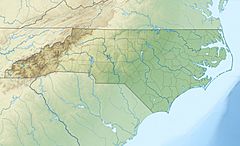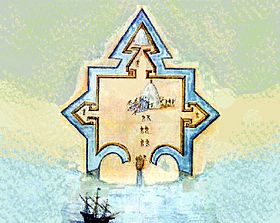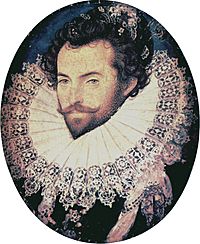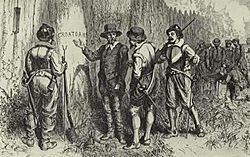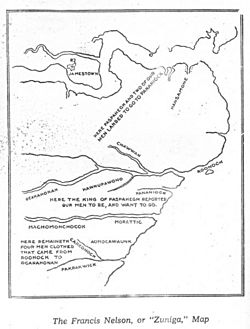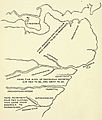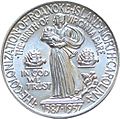Roanoke Colony facts for kids
Quick facts for kids Roanoke Colony |
|
|---|---|
| Colony of England | |
| 1585–1590 | |
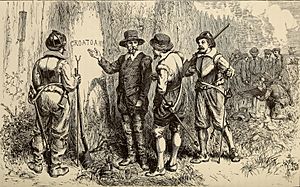
The discovery of the abandoned colony, 1590
|
|
|
Location of Roanoke Colony within what is now North Carolina |
|
| Population | |
|
• 1585
|
Approx. 108 |
|
• 1587
|
Approx. 112–121 |
| Government | |
| Governor | |
|
• 1585–1586
|
Ralph Lane |
|
• 1587
|
John White |
| Historical era | Elizabethan era |
|
• Established
|
1585 |
|
• Evacuated
|
1586 |
|
• Re-established
|
1587 |
|
• Found abandoned
|
1590 |
| Today part of | Dare County, North Carolina, US |
The establishment of the Roanoke Colony ( roh-Ə-nohk) was an attempt by Sir Walter Raleigh to found the first permanent English settlement in North America. The English, led by Sir Humphrey Gilbert, had claimed St. John's, Newfoundland, in 1583 as the first English territory in North America at the royal prerogative of Queen Elizabeth I. The first Roanoke colony was founded by governor Ralph Lane in 1585 on Roanoke Island in what is now Dare County, North Carolina, United States. Following the failure of the 1585 settlement, a second expedition, led by John White, landed on the same island in 1587, and set up another settlement that became known as the Lost Colony due to the subsequent unexplained disappearance of its population.
Lane's colony was troubled by a lack of supplies and poor relations with the local Native Americans. While awaiting a delayed resupply mission by Sir Richard Grenville, Lane abandoned the colony and returned to England with Sir Francis Drake in 1586. Grenville arrived two weeks later and also returned home, leaving behind a small detachment to protect Raleigh's claim.
In 1587, Raleigh sent White on an expedition to establish the "Cittie of Raleigh" in Chesapeake Bay. During a stop to check on Grenville's men, flagship pilot Simon Fernandes forced White's colonists to remain on Roanoke. White, however, returned to England with Fernandes, intending to bring more supplies back to his colony in 1588. The Anglo-Spanish War delayed White's return to Roanoke until 1590, and upon his arrival he found the settlement fortified but abandoned. The cryptic word "CROATOAN" was found carved into the palisade, which White interpreted to mean the colonists had relocated to Croatoan Island. Before he could follow this lead, rough seas and a lost anchor forced the rescue mission to return to England.
The fate of the approximately 112–121 colonists remains unknown. Speculation that they had assimilated with nearby Native American communities appears in writings as early as 1605. Investigations by the Jamestown colonists produced reports that the Roanoke settlers had been massacred, as well as stories of people with European features in Native American villages, but no hard evidence was produced. Interest in the matter fell into decline until 1834, when George Bancroft published his account of the events in A History of the United States. Bancroft's description of the colonists, particularly White's infant granddaughter Virginia Dare, cast them as foundational figures in American culture, and captured the public imagination. Despite this renewed interest, modern research has failed to find archaeological evidence to explain the disappearance of the colonists.
Contents
Background
The enterprise was originally financed and organized by Sir Humphrey Gilbert, who drowned in 1583 during an aborted attempt to colonize St. John's, Newfoundland. Sir Humphrey Gilbert's half-brother Sir Walter Raleigh later gained his brother's charter from the Queen and subsequently executed the details of the charter through his delegates Ralph Lane and Richard Grenville, Raleigh's distant cousin.
Raleigh's charter
On March 25, 1584, Queen Elizabeth I granted Raleigh a charter for the colonization of the area of North America. This charter specified that Raleigh needed to establish a colony in North America, or lose his right to colonization.
The Queen and Raleigh intended that the venture should provide riches from the New World. The queen's charter said that Raleigh was supposed to “discover, search, find out, and view such remote heathen and barbarous Lands, Countries, and territories … to have, hold, occupy, and enjoy.”
The queen's charter also said that Raleigh was supposed to establish a base from which to send privateers on raids against the treasure fleets of Spain. The purpose of these raids was to tell Spain that England was ready for war. The original charter basically told Raleigh to establish a military base to counteract the activities of the Spaniards. Raleigh himself never visited North America, although he led expeditions in 1595 and 1617 to South America's Orinoco River basin in search of the legendary golden city of El Dorado.
First voyages to Roanoke Island
On April 27, 1584, Raleigh dispatched an expedition led by Philip Amadas and Arthur Barlowe to explore the eastern coast of North America. They arrived on Roanoke Island on July 4, and soon established relations with the local natives, the Secotans and Croatoans. Barlowe returned to England with two Croatoans named Manteo and Wanchese, who were able to describe the politics and geography of the area to Raleigh. Based on the information given, Raleigh organized a second expedition, to be led by Sir Richard Grenville.
Grenville's fleet departed Plymouth on April 9, 1585, with five main ships: Tiger (Grenville's), Roebuck, Red Lion, Elizabeth, and Dorothy. A severe storm off the coast of Portugal separated Tiger from the rest of the fleet. The captains had a contingency plan if they were separated, which was to meet up again in Puerto Rico, and Tiger arrived in the "Baye of Muskito" (Guayanilla Bay) on May 11.
While waiting for the other ships, Grenville established relations with the resident Spanish while simultaneously engaging in some privateering against them. He also built a fort. Elizabeth arrived soon after the fort's construction. Grenville eventually tired of waiting for the remaining ships, and departed on June 7. The fort was abandoned, and its location remains unknown.
Tiger sailed through Ocracoke Inlet on June 26, but it struck a shoal, ruining most of the food supplies. The expedition succeeded in repairing the ship and, in early July, reunited with Roebuck and Dorothy, which had arrived in the Outer Banks with Red Lion some weeks previous. Red Lion had dropped off its passengers and left for Newfoundland for privateering.
In the New World
During the initial exploration of the mainland coast and the native settlements, the Europeans blamed the natives of the village of Aquascogoc for stealing a silver cup. As retaliation, the settlers sacked and burned the village. English writer and courtier Richard Hakluyt's contemporaneous reports also describe this incident. (Hakluyt's reports of the first voyage to Roanoke were compiled from accounts by various financial backers, including Sir Walter Raleigh. Hakluyt himself never traveled to the New World.)
Despite this incident and a lack of food, Grenville decided to leave Ralph Lane and 107 men to establish a colony at the north end of Roanoke Island, promising to return in April 1586 with more men and fresh supplies. The group disembarked on August 17, 1585, and built a small fort on the island. There are no surviving renderings of the Roanoke fort, but it was likely similar in structure to the one in Guayanilla Bay.
As April 1586 passed, there was no sign of Grenville's relief fleet. Meanwhile, in June, bad blood resulted from the destruction of the village, and this spurred an attack on the fort by the local Native Americans which the colonists were able to repel. Soon after the attack, Sir Francis Drake was on his way home from a successful raid in the Caribbean, and he stopped at the colony and offered to take the colonists back to England. Several accepted, including metallurgist Joachim Gans. On this return voyage, the Roanoke colonists introduced tobacco, maize, and potatoes to England. The relief fleet arrived shortly after Drake's departure with the colonists. Finding the colony abandoned, Grenville returned to England with the bulk of his force, leaving behind a small detachment of fifteen men both to maintain an English presence and to protect Raleigh's claim to Roanoke Island.
The Lost Colony
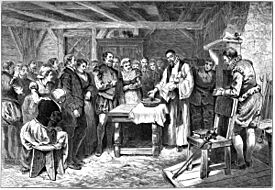
In 1587, Raleigh dispatched a new group of 115 colonists to establish a colony on Chesapeake Bay. They were led by John White, an artist and friend of Raleigh who had accompanied the previous expedition to Roanoke, and was appointed governor of the 1587 colony. White and Raleigh named 12 assistants to aid in the settlement. They were ordered to stop at Roanoke to pick up the small contingent left there by Grenville the previous year, but when they arrived on July 22, 1587, they found nothing except a skeleton that may have been the remains of one of the English garrison.
When they could find no one, the master pilot Simon Fernandez refused to let the colonists return to the ships, insisting that they establish the new colony on Roanoke. His motives remain unclear, however, and new evidence offered by author Brandon Fullam indicates that Fernandez not only had good reason for his actions, but that the decision to alter the Chesapeake Bay destination had already been agreed to prior to their arrival at Roanoke.
White re-established relations with the Croatoan and other local tribes, but those with whom Lane had fought previously refused to meet with him. Shortly thereafter, colonist George Howe was killed by a native while searching alone for crabs in Albemarle Sound.
The colonists persuaded Governor White to return to England to explain the colony's desperate situation and ask for help. Left behind were about 115 colonists – the remaining men and women who had made the Atlantic crossing plus White's newly born granddaughter Virginia Dare, the first English child born in the Americas.
White returns to England
White sailed for England in late 1587, although crossing the Atlantic at that time of year was a considerable risk. Plans for a relief fleet were delayed first by the captain's refusal to return during the winter, and then the attack on England of the Spanish Armada and the subsequent Anglo-Spanish War. Every able English ship joined the fight, leaving White without a means to return to Roanoke at the time. In the spring of 1588, White managed to acquire two small vessels and sailed for Roanoke; however, his attempt to return was thwarted when the captains of the ships attempted to capture several Spanish ships on the outward-bound voyage (in order to improve their profits). They themselves were captured and their cargo seized. With nothing left to deliver to the colonists, the ships returned to England.
Because of the continuing war with Spain, White was unable to mount another resupply attempt for an additional three years. He finally gained passage on a privateering expedition that agreed to stop off at Roanoke on the way back from the Caribbean. White landed on August 18, 1590, on his granddaughter's third birthday, but found the settlement deserted. His men could not find any trace of the 90 men, 17 women, and 11 children, nor was there any sign of a struggle or battle.
The only clue was the word "CROATOAN" carved into a post of the fence around the village, and the letters C-R-O carved into a nearby tree. All the houses and fortifications had been dismantled, which meant that their departure had not been hurried. Before he had left the colony, White instructed the colonists that, if anything happened to them, they should carve a Maltese cross on a tree nearby, indicating that their absence had been forced. There was no cross, and White took this to mean that they had moved to Croatoan Island (now known as Hatteras Island), but he was unable to conduct a search. A massive storm was forming and his men refused to go any farther; the next day, they left.
Thomas Harriot
Born in 1560, Thomas Harriot entered Raleigh's employment in the early 1580s, after graduating from Oxford University. Harriot may have been among the men of Arthur Barlowe's 1584 expedition of the colony. He trained the members of Raleigh's first Roanoke expedition in navigational skills and eventually sailed to Roanoke with the second group of settlers, where his skills as a naturalist became particularly important along with those of painter and settlement leader John White.
Between their arrival in Roanoke in April 1585 and the July 1586 departure, Harriot and White both conducted detailed studies of the Roanoke area, with Harriot compiling his samples and notes into several notebooks that did not survive the colony's disappearance. Harriot also wrote descriptions of the surrounding flora and fauna of the area, which survive in his work A Brief and True Report of the New Founde Land of Virginia, written as a report on the colony's progress to the English government on the request of Raleigh. Viewed by modern historians as propaganda for the colony, this work has become vastly important to Roanoke's history due to Harriot's observations on wildlife as well as his depictions of Indian activities at the time of the colony's disappearance.
Harriot reports that relations between the Roanoke Indians and the English settlers were mutually calm and prosperous, contradicting other historical evidence that catalogs the bloody struggles between the Roanoke Indians and both of Raleigh's commanders, Sir Richard Grenville and his successor, Ralph Lane. Harriot recounts little to none of these accounts in his report to England and does not mention the disorderly state of the colony under either Grenville's or Lane's tenure, correctly assuming these facts would prevent Roanoke from gaining more settlers. Harriot's text did not reach England, or the English press, until 1588, by which time the fate of the "Lost Colony" was sealed in all but name.
Reports of John Smith and William Strachey
Once the Jamestown settlement was established in 1607, efforts were undertaken by the English to acquire information from the Powhatan tribe about Roanoke. The first definitive information concerning the fate of the Lost Colony came from Captain John Smith, leader of the Jamestown Colony from 1608 to 1609. According to chronicler Samuel Purchas, Smith learned from Chief Powhatan that he had personally conducted the slaughter of the Roanoke colonists just prior to the arrival of the Jamestown settlers because they were living with the Chesepians, a tribe living in the eastern portion of the present-day South Hampton Roads sub-region who were related to the Pamlico tribe in Carolina and who refused to merge with the Powhatans. This shocking information was reported to England and by the spring of 1609, King James and the Royal Council were convinced that Chief Powhatan was responsible for the slaughter of the Lost Colony.
The second source of Chief Powhatan’s involvement was William Strachey, Secretary of the Jamestown colony in 1610-11. Strachey’s The Historie of Travaile Into Virginia Britannia seemed to confirm Smith’s report and provided additional information: The colonists had been living peacefully among a group of natives beyond Powhatan’s domain for more than twenty years when they were massacred. Furthermore, Powhatan himself seemed to have directed the slaughter because of prophecies by his priests that he would be overthrown by people from that area, and he reportedly produced several English-made iron implements to back his claim.
The information from these two sources, John Smith and William Strachey, provides the basis for the traditional view that the Lost Colony was slaughtered by Chief Powhatan, and versions of the Powhatan-Lost Colony-slaughter scenario have persisted for more than 400 years. However, no bodies were found and no archaeological evidence has been found to support this claim.
Furthermore, recent re-examination of the Smith and Strachey sources advanced by author and researcher Brandon Fullam has suggested that the massacre described by Powhatan was actually of the 15 people left behind by the first Roanoke expedition, leaving the fate of the second colony still unknown.
Hypotheses about the disappearance
Integration with local tribes
As per Smith's and Strachey's reports, Dr. David Beers Quinn theorized that the colonists moved north to integrate with the Chesepians that Chief Powhatan claimed to have killed. To make the journey northward, Quinn believed that they used the pinnace and other small boats to transport themselves and their belongings. Naturally, if that were the mode of transportation, the colonists could have gone to live in other locations as well.
In her 2000 book Roanoke: Solving the Mystery of the Lost Colony, historian Lee Miller postulated that some of the Lost Colony survivors sought shelter with the Chowanoke, who were attacked by another tribe, identified by the Jamestown Colony as the "Mandoag" (an Algonquian name commonly given to enemy nations). The Mandoag are believed to be either the Tuscarora, an Iroquois-speaking tribe, or the Eno, also known as the Wainoke.
The so-called "Zuniga Map" (named for Pedro de Zúñiga, the Spanish ambassador to England, who had secured a copy and passed it on to Philip III of Spain), drawn about 1607 by the Jamestown settler Francis Nelson, also gives credence to this claim. The map states "four men clothed that came from roonock" were living in an Iroquois site on the Neuse. William Strachey wrote that, at the Indian settlements of Peccarecanick and Ochanahoen, there were reportedly two-story houses with stone walls. The Indians supposedly had learned how to build them from the Roanoke settlers. In both cases, as stated above, it is equally possible that these were survivors of Chief Powhatan's attack of the first colonists.
There were also reported sightings of European captives at various Indian settlements during the same time period. Strachey wrote in 1612 that four English men, two boys and one girl had been sighted at the Eno settlement of Ritanoc, under the protection of a chief called Eyanoco. Strachey reported that the captives were forced to beat copper and that they had escaped the attack on the other colonists and fled up the Chaonoke river, the present-day Chowan River in Bertie County, North Carolina.
John Lawson wrote in his 1709 work, A New Voyage to Carolina, that the Croatans living on Hatteras Island used to live on Roanoke Island and claimed to have white ancestors:
A farther Confirmation of this we have from the Hatteras Indians, who either then lived on Ronoak-Island, or much frequented it. These tell us, that several of their Ancestors were white People, and could talk in a Book, as we do; the Truth of which is confirm'd by gray Eyes being found frequently amongst these Indians, and no others. They value themselves extremely for their Affinity to the English, and are ready to do them all friendly Offices. It is probable, that this Settlement miscarry'd for want of timely Supplies from England; or thro' the Treachery of the Natives, for we may reasonably suppose that the English were forced to cohabit with them, for Relief and Conversation; and that in process of Time, they conform'd themselves to the Manners of their Indian Relations.
From the early 17th century to the middle 18th century, European colonists reported encounters with gray-eyed American Indians who claimed descent from the colonists (although at least one, a story of a Welsh priest who met a Doeg warrior who spoke the Welsh language, is likely to be a hoax). Records from French Huguenots who settled along the Tar River in 1696 tell of meeting Tuscaroras with blond hair and blue eyes not long after their arrival. As Jamestown was the nearest English settlement, and they had no record of being attacked by Tuscarora, the likelihood that the origin of those fair-skinned natives was the Lost Colony is high.
Fred Willard and Phillip MacMullan believe that the colonists along with the Croatans relocated to villages along the Alligator River in an area known as "Beechland", slightly inland from Roanoke Island. Archeological remains of settlements has been discovered in the area, including coffins with Christian markings on them where there had been no previous record of a grave site, but their hypothesis is mostly based on oral histories and also lacks any definitive evidence.
In the late 1880s, North Carolina state legislator Hamilton McMillan discovered that his "redbones" (those of Indian blood) neighbors in Robeson County claimed to have been descended from the Roanoke settlers. He also noticed that many of the words in their language had striking similarities to obsolete English words. Furthermore, many of the family names were identical to those listed in Hakluyt's account of the colony. Thus on February 10, 1885, convinced that these were the descendants of the Lost Colony, he helped to pass the "Croatan bill", that officially designated the population around Robeson county as Croatan. Two days later on February 12, 1885, the Fayetteville Observer published an article regarding the Robeson people's origins. This article states:
They say that their traditions say that the people we call the Croatan Indians (though they do not recognize that name as that of a tribe, but only a village, and that they were Tuscaroras), were always friendly to the whites; and finding them destitute and despairing of ever receiving aid from England, persuaded them to leave [Roanoke Island], and go to the mainland... They gradually drifted away from their original seats, and at length settled in Robeson, about the center of the county...
However, the case was far from settled. A similar legend claims that the now extinct Saponi of Person County, North Carolina, are descended from the English colonists of Roanoke Island. However, no documented evidence exists to link the Saponi to the Roanoke colonists.
Other tribes claiming partial descent from surviving Roanoke colonists include the Catawba (who absorbed the Shakori and Eno people), and the Coree and the people who call themselves the Lumbee. Samuel A'Court Ashe was convinced that the colonists had relocated westward to the banks of the Chowan River in Bertie County, and Conway Whittle Sams claimed that after being attacked by Wanchese and Powhatan, the colonists scattered to multiple locations: the Chowan River, and south to the Pamlico and Neuse Rivers.
Other theories
Spanish
Another theory is that the Spanish destroyed the colony. Earlier in the century, the Spanish did destroy evidence of the French colony of Fort Charles in coastal South Carolina and then massacred the inhabitants of Fort Caroline, a French colony near present-day Jacksonville, Florida. However, a Spanish attack is unlikely, as the Spanish were still looking for the location of England's failed colony as late as 1600, ten years after White discovered that the colony was missing.
Dare Stones
From 1937 to 1941, a series of stones were discovered that were claimed to have been written by Eleanor Dare, mother of Virginia Dare. They told of the travelings of the colonists and their ultimate deaths. Most historians believe that they are a fraud, but there are some today who still believe at least one of the stones to be genuine.
Virginia Pars Map
In May 2011, Brent Lane of the First Colony Foundation was studying the Virginia Pars Map, which was made by John White during his 1585 visit to Roanoke Island, and noticed two patches where the map had been corrected. The patches are made of paper contemporaneous with that of the map. Lane asked researchers at the British Museum in London, where the map has been kept since 1866, what might be under the patches, sparking a research investigation. On May 3, 2012, at Wilson Library of the University of North Carolina at Chapel Hill, members of the Foundation and representatives of the museum announced the discovery of "a large, square-shaped symbol with oddly shaped corners." This symbol, presumed to represent a fort, is visible when the map is viewed on a light box. Some scholars speculate that the colonists relocated to that location, on what is now called Salmon Creek in the Bertie County community of Merry Hill. The Scotch Hall Preserve golf course community was planned on the site, but it has not been fully developed.
The discovery of new information on the map led to more study of artifacts previously found, as well as additional digs in 2012 and 2014.
Archaeological evidence
In 1998, East Carolina University organized "The Croatoan Project", an archaeological investigation into the events at Roanoke. The excavation team sent to Hatteras Island uncovered a 10 karat (42%) gold 16th-century English signet ring, gun flints, and two copper farthings (produced sometime in the 1670s) at the site of the ancient Croatoan capital, 50 miles (80 km) from the old Roanoke Colony. Genealogists were able to trace the lion crest on the signet ring to the Kendall coat of arms, and concluded that the ring most likely belonged to one Master Kendall who is recorded as having lived in the Roanoke Colony from 1585 to 1586. If this is the case, the ring represents the first material connection between the Roanoke colonists and the Native Americans on Hatteras Island.
It is also believed that the reason for the extreme deficiency in archaeological evidence is due to shoreline erosion. Since all that was found was a rustic looking fort on the north shore, and this location is well-documented and backed up, it is believed that the settlement must have been nearby. The northern shore, between 1851 and 1970, lost 928 feet because of erosion. If in the years leading up to and following the brief life of the settlement at Roanoke, shoreline erosion was following the same trend, it is likely the site of the dwellings is underwater, along with any artifacts or signs of life. Archaeological investigations continue to find tantalizing clues and funding is being sought to continue recent excavations.
Climate factors
In 1998, a team led by climatologist David W. Stahle, of the University of Arkansas and archaeologist Dennis B. Blanton of the College of William and Mary used tree ring cores from 800-year-old bald cypresses taken from the Roanoke Island area of North Carolina and the Jamestown area of Virginia to reconstruct precipitation and temperature chronologies.
The researchers concluded that the settlers of the Lost Colony landed at Roanoke Island in the summer of the worst growing-season drought in 800 years. "This drought persisted for 3 years, from 1587 to 1589, and is the driest 3-year episode in the entire 800-year reconstruction," the team reported in the journal Science. A map shows that "the Lost Colony drought affected the entire southeastern United States but was particularly severe in the Tidewater region near Roanoke [Island]." The authors suggested that the Croatan who were shot and killed by the colonists may have been scavenging the abandoned village for food as a result of the drought.
Lost Colony of Roanoke DNA Project
The Lost Colony of Roanoke DNA Project was founded in 2007 by a group led by Roberta Estes, who owns a private DNA-testing company, in order to solve the mystery of the Lost Colony using historical records, migration patterns, oral histories and DNA testing. The project used Y chromosome, Mitochondrial DNA and Autosomal DNA. As of 2016[update], they have not yet been able to positively identify any descendants of the colony.
Portrayals and re-enactments
Pulitzer Prize-winning playwright Paul Green wrote The Lost Colony in 1937 to commemorate the 350th birthday of Virginia Dare. The play presents a conjecture of the fate of Roanoke Colony. It has played at Waterside Theater at Fort Raleigh National Historic Site on Roanoke Island nearly continually since, with the only interruption being during World War II. Alumni of the cast include Andy Griffith (who played Sir Walter Raleigh), William Ivey Long, Chris Elliott, Terrence Mann, and The Daily Show correspondent Dan Bakkedahl.
The Roanoke Colony formed the basis for the sixth season of the FX horror anthology television series American Horror Story.
Images for kids
-
Plymouth, Devon, was the burgeoning home port of Drake, Gilbert, Grenville, and Raleigh
-
The 1585 assault on Aquascogoc village
-
An artist's rendering of Ralph Lane's Roanoke fort; author unknown, 1962
-
La Virginea Pars map, by John White
-
Archaeological research dig at Fort Raleigh National Historic Site (2009)
-
Re-creation of the tree inscribed with "CRO", from a production of The Lost Colony
See also
 In Spanish: Colonia de Roanoke para niños
In Spanish: Colonia de Roanoke para niños


